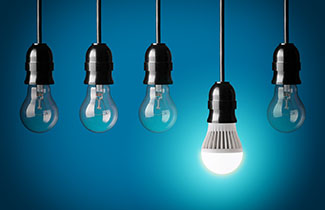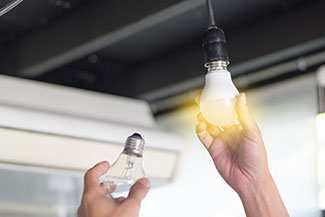To LED or Not To LED
To LED, or Not To LED, That is the question
Have you been holding out making the switch from traditional compact fluorescent light bulbs (CFLs) or incandescent to light-emitting diode (LED)? If you are not sure if it makes sense for your home, let's compare them.
September Tanner, Service Manager, Fox Valley Electric, a Rosie-Certified Partner explains the differences and benefits.
The main difference between CFLs and incandescent bulbs is how much energy it takes to use them over time. CFLs use about 70 percent less energy than incandescent bulbs. LEDs use only about 10 percent of the energy of a traditional light bulb, and they last up to 15 years, so you should rarely have to change the old one.
"An LED is not a light bulb, but it acts like one. It is actually a tiny semiconductor that generates light when electricity is passed through it," said Tanner. "If you have a microwave oven or DVD player with a digital display, it probably contains an LED."
LEDs cost more than CFLs. An incandescent bulb is about $1 and a CFL is less than $5. LED prices were pretty costly a few years ago. They have come down quite a lot and cost between $10 to $20. The lower the price, the faster the bulbs pay for themselves, providing you buy good quality bulbs.
LEDs are different from incandescent lights in two other ways:

First, LED light is directional. It shines light in a single direction onto the surface it's pointed it to. Incandescent and fluorescent bulbs are non-directional. They send light out in all directions, so they fill a space with light. So, if you're switching to LEDs be sure to get the LEDs that are designed for the application you are intending.
LEDs are not always the same color as incandescents. The incandescent bulbs we're used to at home are a warm white or slightly amber color. LEDs emit a cool bluish light and come in a variety of colors, including warm white and amber.
LEDs use about 90 percent less energy than a traditional incandescent bulb, while CFLs save 75 percent. Plus, CFLs and LEDs emit little to no heat, while incandescents spend 90 percent of their energy-producing heat and only 10 percent on light.
An LED can last up to 25 times longer than a similar incandescent bulb; it also burns cooler. According to a local utility company calculator, if you buy 10 reflector LEDs to replace incandescents in ceiling can lights, your total average savings can be as much as $90 a year depending on the wattage of bulbs. Many Arizona utilities like SRP and APS offer discounts for LEDs bought at participating retailers.
"Some people like LEDs better than energy-efficient compact fluorescent light bulbs (CFLs) because they are easier to dim and turn on without the slight pause that you get when you switch on a CFL. Plus, they don't contain any mercury. CFLs contain a trace amount of mercury," said Tanner.
Light On!
You can use LEDs anywhere you need light. You might want to try a few out before you make the expenditure to replace all of your fixtures.
Accent Lighting
LEDs come in an array of colors, and you can program some fixtures to make the lights change colors on a schedule. If you like colored lights, try installing LEDs as accent lights around artwork, in hallways and on staircases.
Task Lighting
Choose a warm amber or bright white light, depending on your preference, for reading lamps, flashlights and anyplace you don't have much space. LEDs are tiny and can fit almost anywhere.
Area Lighting

Light a whole room in your house with a track of overhead LEDs. Start small to make sure the color of the light is one you can live with.
Decorative Lighting
Hide LEDs in crown molding and dropped ceilings to highlight your home's unique architectural details. You can also program your LEDs to put on a multicolor light show without using a color wheel or any moving parts.
Swimming Pool
Traditional underwater pool lights can use 400 or 500 watts of electricity. An energy-saving alternative is an LED (light-emitting diode), which uses up to 75 percent less energy than incandescent underwater lights. LEDs last for years and come in multiple colors as well as white.
Making The Switch
For the closest match, choose a 6-watt-equivalent LED to replace your 60-watt incandescent bulb.
Perhaps the easiest fix of all is putting LED bulbs in your overhead can lights. LEDs or light emitting diodes are more energy-efficient as well as being brighter and longer-lasting than incandescents or even CFLs (compact fluorescents).
So, go on out there and let your light shine!
###
Home Maintenance To-Do | Update old bulbs to #LEDbulbs
Sponsored by: Fox Valley Electric
 Since 2007, Fox Valley Electric has provided quality electrical construction, service and maintenance to their customers in the Phoenix metropolitan area. Their electricians can install anything from new security lighting to a whole-home generator that will keep appliances working during a power outage.
Since 2007, Fox Valley Electric has provided quality electrical construction, service and maintenance to their customers in the Phoenix metropolitan area. Their electricians can install anything from new security lighting to a whole-home generator that will keep appliances working during a power outage.
Photo Credits:
- Shutterstock
RELATED CONTENT:
- Blog: Want To Join The LED Revolution?
- Blog: Throw New Light on Your Life
- Blog: What You Need To Know To Buy A Light Bulb
- DIY FAQ: Four DIY Projects That Help Pay For Themselves
- DIY FAQ: What's the difference between Watts and Lumens?
- DIY FAQ: Can I Add Security Lighting Without Raising My Energy Bill?
- DIY FAQ: How Can I Get More Natural Light in My Home?
- Podcast: What You Need to Know to Buy a Light Bulb
